-
Paper Information
- Paper Submission
-
Journal Information
- About This Journal
- Editorial Board
- Current Issue
- Archive
- Author Guidelines
- Contact Us
International Journal of Internet of Things
2016; 5(2): 41-48
doi:10.5923/j.ijit.20160502.01

The Impact of Application of WiMAX in Tanzania
Edward Marco Kwesigabo
The Institute of Finance Management (IFM), Dar es Salaam, Tanzania: Current Research Scholar Acharya Nagarjuna University, India
Correspondence to: Edward Marco Kwesigabo, The Institute of Finance Management (IFM), Dar es Salaam, Tanzania: Current Research Scholar Acharya Nagarjuna University, India.
| Email: |  |
Copyright © 2016 Scientific & Academic Publishing. All Rights Reserved.
This work is licensed under the Creative Commons Attribution International License (CC BY).
http://creativecommons.org/licenses/by/4.0/

This paper has studied the Implication of WiMAX in improving internet connectivity in Tanzania Local Government Authority (LGA). Installation of WiMAX is cheap it spans over large area compared with traditional broadband and WiFi. Potential application capabilities are extended to bring them closer to subscribers, filling the gaps in cable DSL and T1 services. It was observed only (14.9%) of its population use internet [1]. This user is very few compared to other African country. Many factors were found which prevent many people from using the internet which includes poor infrastructure, illiteracy, and cost of internet services. This paper found that WiMAX is not only solution for attractive internet connection without proper investment on internet infrastructure especially in underserved environment.
Keywords: WiMAX, wi-fi, Internet, Broadband
Cite this paper: Edward Marco Kwesigabo, The Impact of Application of WiMAX in Tanzania, International Journal of Internet of Things, Vol. 5 No. 2, 2016, pp. 41-48. doi: 10.5923/j.ijit.20160502.01.
Article Outline
1. Introduction
- Historically internet access in Tanzania was started in 1995 and it was enabled by broadband and WiFi which was limited by transmission power antenna and the type of location they are used and environment. These lead higher internet utilization in cities, municipal, city councils and town council where people are concentrated in one place like Dar es Salaam, Mwanza, Mbeya and Arusha while in town council and small town councils where offices located in upcountry there is no internet infrastructure and still internet utilization is low. Local government staffs started enjoying internet utilization in 2010 when Worldwide Interoperability for Microwave Access (WiMAX) was adopted. The WiMAX provides worldwide area coverage and quality of service capabilities for application ranging from real – time delay – sensitive voice - over – IP (VoIP) to real time streaming download, ensuring that the subscribers obtain the performance they expect for all types of communications. It is a wireless digital communications system (IEEE 802.16) that is intended for wireless "metropolitan area networks". The WiMAX can provide broadband wireless access (BWA) up to 30 miles (50 km) for fixed stations and 3 - 10 miles (5 - 15 km) for mobile stations. In contrast, the Wi-Fi (Wireless Fidelity)/802.11 a wireless local area network standard is limited in most cases to only 100 - 300 feet (30 - 100m). In such cases WiMAX has enabled services even in the area that was difficult for wired infrastructure to reach ability to overcome the physical limitation of tradition infrastructure [4].However, with all the odds, adoption and subsequent application of the WiMAX the use of internet as a service has been on an upward trend in Tanzania even though the speed has been slow. This arises from the fact that network coverage is not extensive enough bearing in mind infrastructural costs, literacy levels and poverty. Since the installation of high speed fiber optic backbone cable in 2010, the subsequent connections by the Internet Service Providers occurred in subsequent years. Hence, the effects of the benefits of this fiber optic project are yet to be felt to the larger population of the society. The lack of affordable and high capacity internet connection products from the Internet Service Providers (ISPs) further frustrates the efforts to improve accessibility to this commodity while the demand is steadily increasing. This has been mainly brought about by the sophistication of the technology in use. The evolution of the communication has changed of equipment from those that supported analog signal technology to those that currently and fully support digital signals. The lifespan of equipment for example a Base Station or a digital switch cannot go beyond several tens of years thus requiring the equipment to be totally overhauled or completely replaced. With this upward trending of the internet usage and introduction of WiMAX technology in 2010 in Tanzania some questions become imperative; how extensive has the WiMAX technology concept been adopted, deployed and used to improve service delivery as compared to earlier modes of internet connectivity methods that have been used? Is the existing network infrastructure sufficient? Did the number of users increase after the adoption of WiMAX in local government, what explains this increase? The aim of this research paper is therefore to assess the impact of the adaption and subsequent use of WiMAX technology in local Government in Tanzania.
2. Review of Related Empirical Studies
- The history of broadband wireless as it relates to WiMAX can be traced back to the desire to find a competitive alternative to traditional wire line-access technologies [7]. Prompted by the deregulation of the telecom industry and the rapid growth of the Internet, several competitive carriers were motivated to find a wireless solution to bypass incumbent service providers. During the past decade or so, a number of wireless access systems have been developed, mostly by start-up companies motivated by the disruptive potential of wireless [5]. These systems varied widely in their performance capabilities, protocols, frequency spectrum used, applications supported and a host of other parameters. Some systems were commercially deployed only to be decommissioned later. Successful deployments have so far been limited to a few high end applications and markets. Clearly, broadband wireless has until now had a checkered record, in part because of the fragmentation of the industry due to the lack of a common standard WiMAX technology has evolved through four stages, although not fully distinct or clearly sequential: (1) narrowband wireless local-loop systems, (2) first-generation line-of-sight (LOS) broadband systems, (3) second-generation non-line-of-sight (NLOS) broadband systems, and (4) standards-based broadband wireless systems [14]. Several wireless technologies have been targeted primarily for data transmission. Bluetooth is a standard used to build small networks between peripherals: a form of "wireless network" interconnecting devices [13]. This technology brought much anticipation in the networking industry. Third-generation (3G) mobile telephony networks are also familiar networks. They promise data rates of megabits per cell, as well as the "always on" connections that have proven to be quite valuable to Digital Subscriber Lines and cable modem customers. In contrast to Bluetooth and 3G, equipment based on the IEEE 802.11 standard has been an astounding success [14]. Products based on 802.11 were initially released in 1997. 802.11 included an infrared layer that was never widely deployed as well as two spread-spectrum radio layers: frequency hopping and direct sequence.Initial 802.11 products were limited to 2 Mbps, which is quite slow by modern network standards. The IEEE 802.11 working group quickly began working on faster radio layers and standardized both 802.11a and 802.11b in 1999. Products based on 802.11b were released in 1999 and can operate at speeds of up to 11Mbps. 802.11a uses a third radio technique called orthogonal frequency division multiplexing. 802.11a operates in a different frequency band entirely and currently has regulatory approval only in the United States. As you can see from the table, 802.11 already provide speeds faster than 10BASE-T Ethernet and reasonably competitive with Fast Ethernet [13]. The wireless landscape is changing rapidly as influenced by the following factors: deregulation, convergence of the Internet and telecommunications and continuous evolution of network technologies and terminal capabilities [6]. In home and office settings, Worldwide Interoperability for Microwave Access (WiMAX) networks are a popular alternative to wired networks, because of the ease, speedand cost-effectiveness with which they can be deployed. WiMAX is a telecommunications technology that provides wireless transmission of data using a variety of transmission modes such as radio spectrum to transmit tens of megabits per second in bandwidth of (audio, data and video) from point-to-multipoint. It is a wireless industry coalition dedicated to the advancement of IEEE 802.16 standards for broadband wireless access (BWA) networks [4]. This technology addresses broadband wireless metropolitan access networks (MANs) that use a point-to-multipoint architecture. The standard defines the use of bandwidth between the licensed 10GHz and 66GHz and between the 2GHZ and 11GHz (licensed and unlicensed) frequency ranges [5]. WiMAX can be summed therefore as a communication technology that connects devices using a wireless infrastructure with a considerable amount of speed. Telecommunications Technology is being pushed beyond its limits as new inventions and innovations are developed. [5] Outlay the ability of WiMAX to interoperate between network devices as well as offer scalability between radio access technology and network architecture. These abilities are measured using five different features of this technology. These features include: scalability, high data rates, Quality of Service, security and mobility. Scalability is the ability to expand the network in order to meet the ever growing user demands with minimal or no interruptions at all in terms of service availability to users due to an expansion process [4]. In view of any network, scalability is viewed in terms of how many subscribers can be supported, the speed of data transmission in uploading and downloading as well as the ability to cover a geographically wide area. WiMAX as a technology is characterized by high data rates compared to its predecessor Wi-Fi with speeds of up to 134 Mbps in frequencies between 10-66 GHz. WiMAX is optimized to deliver high data rates to subscriber stations enabling it to extend wireless connectivity beyond the limits of today’s systems, both in distance and in the ability to support applications [8]. Quality of service is the ability to ensure the delivery of a product on time or service without altering its original content or structure. The ability for WiMAX to stream audio, data and video is crucial, hence service providers should have the ability to manage traffic based on each subscriber’s service agreement on a link-by-link basis [18] Security is a crucial feature in most of the services provided by institutions. In order to ensure protection against data theft and fraud, WiMAX utilizes a wide range of security features to ensure secured data exchange for example: terminal authentication by exchanging certificates to prevent rogue devices(devices that are used to attack and hack the network for malicious intents), user authentication using the Extensible Authentication Protocol (EAP), data encryption using the Data Encryption Standard (DES) or Advanced Encryption Standard (AES), both of which are much more robust than the Wireless Equivalent Privacy (WEP)standard initially used by WLAN [12]. Furthermore, each service is encrypted with its own security association and private keys. In terms of mobility, Wireless enables better communication, enhances productivity, and enables better customer service. A wireless communications system allows users to access information and conduct business from anywhere. The IEEE 802.16e (WiMAX) standard provides for mobility along with carrier-class features and reliability. Further, these standards provide for high-level data security, quality of service sufficient for voice, data, as well as video applications, high level of reliability, and guaranteed service levels [6]. WiMAX access is rapidly growing in countries that already have well developed fixed and mobile telecommunications networks as well as in countries with a weak telecommunications infrastructure. In the case of developed markets, the service in terms of bit rate (data transmission speed) is improving, and the tariff is gradually reducing. Although in underdeveloped economies the thrust has been to extend the reach of broadband services, the tariffs are going down while access is improving. A major global trend unfolding today is the increasing importance and prominence of wireless access technologies. Today, broadband wireless access is seen as a solution capable of filling the gaps left by wire technologies while ensuring quality service provision in a competitive market [12]. Broadband Wireless Access (BWA) is a solution to meet the escalating demand of both broadband starved regions and the massive growth of the use of Internet. The emerging BWA will provide realistic services, including rural areas as a last-mile solution; urban deployments as an alternative to low-cost, self-installed fixed broadband (digital subscriber line (DSL) and cable) services; and in developing regions where there is little or no wired infrastructure. Also security concerns have inspired many cities to embrace broadband wireless solutions for surveillance [4]. The IEEE (Institute of Electrical and Electronics Engineering) is a body that is mandated with the development and classification standards. The evolution of WiMAX as a technology also conforms to the specification of the IEEE. The predecessor technologies to WiMAX have included: the IEEE 802.11 a standard which refers to the Wi-Fi a wireless LAN technology. These two technologies share similarities even though they are developed for totally different applications [13]. Wi-Fi was initially developed with the sole purpose of adding mobility to the private wired LANs while WiMAX was meant to deliver a metropolitan area broadband wireless access (BWA) [12]. The idea behind the invention of WiMAX was to provide a fixed wireless internet access service to compete with cable modems and digital subscriber lines (DSL).A significant advantage that is posed with WiMAX is its ability to support transmission ranges of up to 30 miles while its predecessor Wi-Fi can support up to 3 miles. Though a clear difference between WiMAX and Wi-Fi is transmission range, there are a number of improvements that distinguish WiMAX from Wi-Fi which include: Radio Link Interfaces where Wi-Fi operates at frequency ranges between 2.4 – 5 GHz frequencies while WiMAX operates between frequencies of 10 – 66 GHz bands. These frequencies are crucial since they define Line of Sight (LOS) and Non Line of Sight (NLOS) [7]. A line of sight defines a clear path between a transmitter and a receiver component. This therefore means that high end frequencies (2.4 – 5 GHz) frequencies need a clear LOS while low end frequencies (10 – 66 GHz) do not require a clear LOS between the customer unit and the best station making WiMAX a better choice [15].
3. Research Methodology
- Tanzania has one hundred and forty (140) Local Government Authority (LGAs) which include city councils, municipal councils, town councils and district councils. The study established a sample of 10% of total number of Tanzania LGA. The study established a sample of ten percent of the total number of LGAs. The established sample of fourteen (14) LGAs comprised 11 District councils, 1 Town council, 1 Municipal council and one (1) city council. The established sample took in account the proportional number of each type of councils. To achieve the objective of the study, the author employed structured questionnaire to collect primary data from local government employees on the general internet utilization. Questionnaires were distributed randomly in the selected group of local government employees, scientific method was used to select the respondent and the questionnaire was mailed. These questionnaires were self administered and respondent was asked to submit the questionnaires after filling. A total of two hundred (200) questionnaires were collected from respondent as follows; fifteen (15) questionnaires from city council, twenty five (25) questionnaires town council, forty (40) questionnaires from municipal council and one hundred and twenty (120) questionnaires from district council.Also review/desk study was used to get more detail of subject matter. The aim was to investigate how WiMAX was improved network connectivity in Tanzanian local governments. This method enables the author to assess the current internet utilization in public sector. SPSS was used to analyses quantitative data in which charts and table have been used to present the findings.
4. Results Presentation and Analysis
- This paper aims to present the field or empirical data on the impact of the WiMAX in Tanzania. This section is bestowed for the presentation analysis and discussion of results. As described in section three the paper follows factor analysis design such that the results of each specific research objectives are arranged in a systematic order.
4.1. Characteristics of the Respondents
- Chat 1 represent the percentage number of participants engaged in the survey of this research by age. From the graph above it is clearly noticed that the active age limits where internet services are mostly utilized are between the ages of 21 years and 40 years. These age brackets form the bulk of active internet users. In Tanzania this age group of 21 – 30 years is newly employees from college; this is active generation group whom consider internet as the part of working tools.
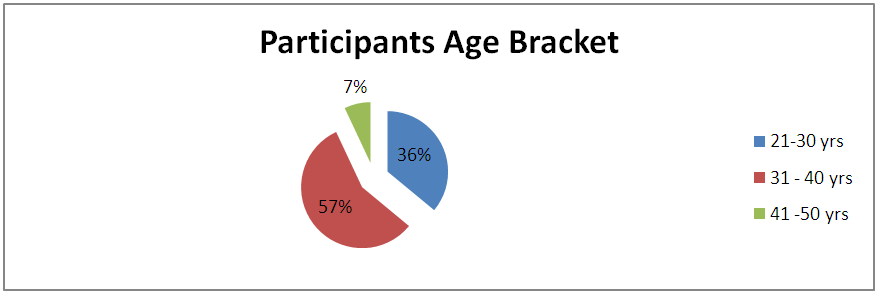 | Chart 1. Representation of the ages of the participants of the survey |
4.2. Internet Utilization by Sampled Population
- Chart 2 represents internet utilization by users. The bulk of activity by most users include general information search, email exchange, chatting and conducting business as well as downloading and video streaming. Some of these activities require high bandwidth for them to take effect especially downloading and video streaming.
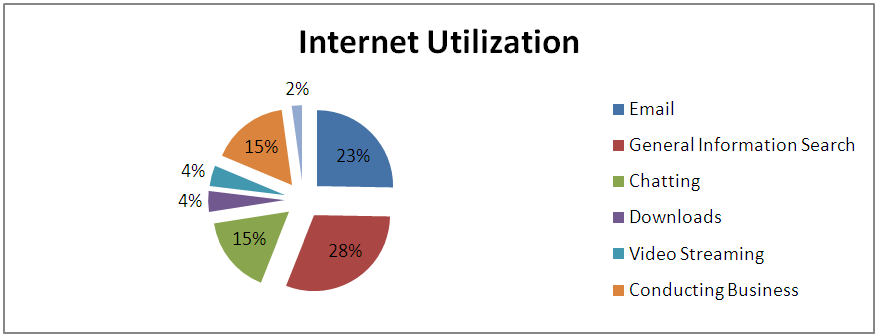 | Chart 2. Internet utilization by surveyed participants |
 | Chart 3. Commonly used internet connection gadgets |
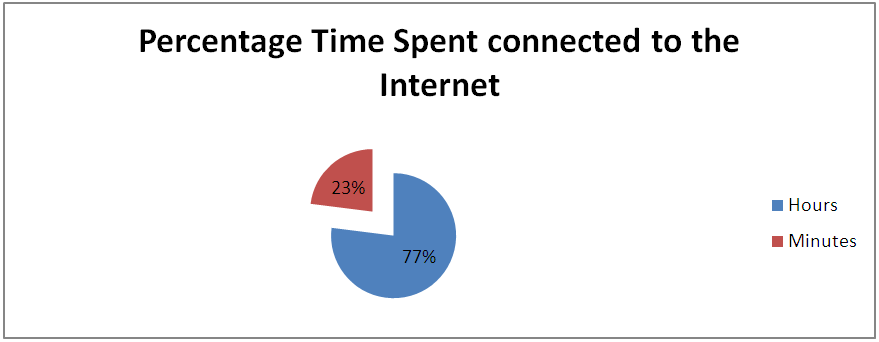 | Chart 4. Time spent connected to the internet |
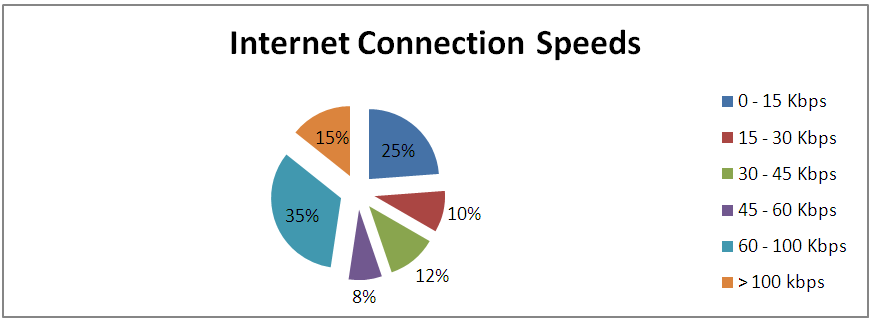 | Chart 5. Download speeds experienced by internet users |
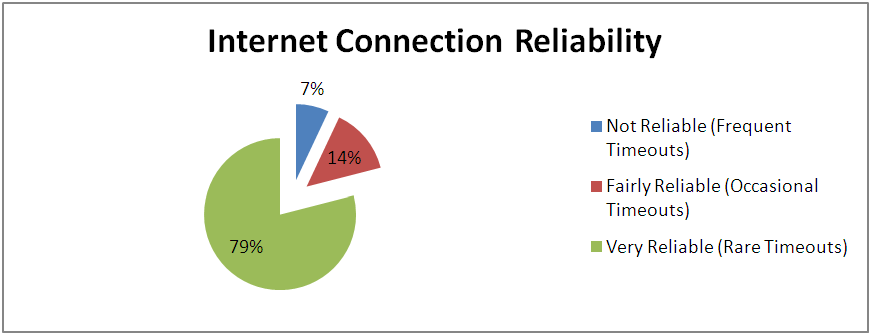 | Chart 6. Reliability of the connection experienced by internet users |
5. Discussion of Results
- WiMAX technology in Tanzania has expanded internet coverage and internet has become more reliable compared to the past. It has improved speed, connection reliability and it has attracted many users according to different age. It was found most of user ranges between 20 – 40, these are employed group from colleges who have new positive thinking about the usage of internet, they use internet for studying, communications and for business. WiMAX has enabled connectivity beyond of physical limit which lead local government to use internet services as a mandatory service for some of its services. Which enables information sharing, video conferencing, learn new idea, resource sharing and tax collection records.Backhaul comprise network components which connect client/subscriber access sections of networks with their core switching and management topologies. Service providers therefore require WiMAX as their underlying technology essential for ensuring continuous delivery of rich media service across high speed data networks enabling user to download data, watch video streaming and generating income by conducting business.Wireless microwave backhaul provides bandwidth flexibility and it thrives in places where fiber is either too expensive or is unavailable.WiMAX is a versatile technology has enabled different service providers to offer rich media and data-oriented services over wireless broadband networks. It fits the strategy of current Telecommunication companies, cable companies, satellite operators and broadband ISPs without a wireless play to extend their services in cities and rural areas, also in rural people are enjoying internet utilization.The ability for WiMAX to have a span radius of 30 miles qualifies it a last mile infrastructure network. This allows more customers to have a stable and error-free link with almost zero failure rates, and able to offer competitive broadband rates to both current and new customers.

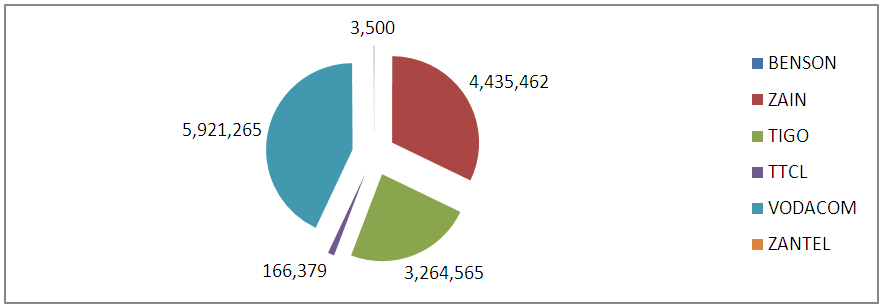 | Chart 7. Market Share by Internet Service Providers in Tanzania |
6. Conclusions and Recommendations
- This is exploratory study aimed to assess the impact of WiMAX application in local government Tanzania. The results have revealed that WiMAX has provided high speed, reliability, improved connectivity, broad coverage and cost-effective fixed and mobile broadband access solution. Voice over Internet Protocol, backhaul, last mile and rural connectivity are the main usages of WiMAX. The targeted users include residential, business, and mobile users. Analysis of WiMAX technology indicates that it have some advantages compare to Wi-Fi, 3G, Digital Subscriber Line and Cable technology. WiMAX has attracted many user as it spans over large area compared to traditional WiFi and broadband, also it has enabled people to share information without tired as the network has higher speed and more reliability.From short-term angle of view, WiMAX has not replaced any of these services, since they are defined for different use than WiMAX and already have market-based groundwork in terms of installation of infrastructure and user acceptance. Even though cost analysis reveals that WiMAX has cost-effectiveness and high capacity advantage in local government due to its ability to support long distance coverage, compared with Asymmetrical Digital Subscriber Line, however WiMAX does not have obvious cost advantage in urban and suburban areas.A successful Broadband Wireless Access business depends on a stable and comprehensive industrial ecosystem built around the stakeholders. These stakeholders include telecommunication operators, service provider, equipment vendor, system integrators, component vendors, and users. There are three primary elements to build a healthy telecommunications ecosystem -good standards which should be studied extensively, developed and tested thoroughly, cross industry cooperation between various stakeholders and available devices to support the technology in question. WiMAX has well-developed standardization process which can help to gain trust from customers, promote the competition of various vendors and thus lower down the price of product. However WiMAX has simplified network connection amongst local government in Tanzania, the number of users remain relatively very low (14.9%) compared to other African countries such as Kenya (69.6%), Morocco (60.6%), Egypt (54.6%), South Africa (49%) and Senegal (51.1%).So there is serious need for the government to create enabling investment environment to investors so they can expand network infrastructure to underserve part especially wards and villages which are scattered and people living under poverty. In future works we study why internet are underutilized in Tanzania.
Notes
- 1. Number of Tanzanian Local Government Authorities as reported in the CAG general report on LGAs for the financial year 2012/13.2. http://www.internetworldstats.com/africa.htm accessed 29 January 2016.
 Abstract
Abstract Reference
Reference Full-Text PDF
Full-Text PDF Full-text HTML
Full-text HTML